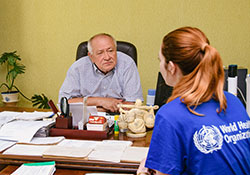“We don’t have enough medicines to treat our patients”

ARTEM GETMAN
Since the conflict in eastern Ukraine started in 2014, the city of Kramatorsk has become the temporary administrative centre of the Donetsk region. Its oncology centre now serves almost 1 million people, explains Dr Oleskandr Ptitsa, Chief Medical Doctor. Other medical institutions often use its surgery facilities. “Since the beginning of the conflict in eastern Ukraine, the number of surgeries has nearly tripled,” he explains.
However, some 130 facilities still remain either partially or fully nonoperational due to shelling, seriously limiting access to critical health care. Over 400 health facilities in conflict areas report insufficient stocks of medicines – including insulin and treatment for kidney failure – and other supplies.
Disruption in the delivery of medicines and supplies is one of the key challenges for the oncology centre, along with outdated equipment and lack of human resources. “Life-saving treatment for cancer patients is often not available,” reports Dr Ptitsa. “We are still waiting for chemotherapy supplies planned for 2016, and most of the health-care expenses are covered out of pocket by patients.”
Health-care facilities along the contact line depend on humanitarian health assistance
Kramatorsk’s oncology centre is one of 21 health-care facilities in government-controlled areas (GCA) of eastern Ukraine that have received surgical kits from WHO in 2017. “Some of the supplies we receive are in storage for emergency needs in case of conflict escalation,” says Ms Nataliya Krasyuk, Chief Nurse at the centre.
In 2017 alone, with financial support from the German Government, WHO supplied 11 tonnes of surgical medicines and medical supplies to health facilities in GCA near the contact line. In addition to the shipment of surgical kits, WHO delivered primary care supplies to support up to 1.2 million patients on both sides of the contact line. WHO also supplied critical neonatal equipment to ensure safe deliveries as well as neonatal resuscitation for 58 paediatric and obstetric units.



